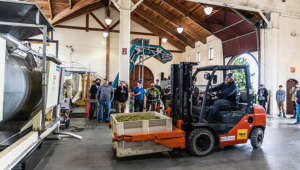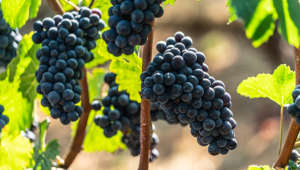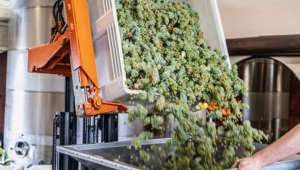All grapes are not created equal. In addition to our own estate-grown grapes, King Estate works with some 55 vineyard partners throughout the Northwest who are carefully selected for the consistently high quality of their fruit. Many of these partners have been with us for years, and we know that we can count on them to send us grapes worthy of our label. Once the fruit comes in, there are still a whole host of decisions to be made to determine which grapes are right for which wines. The winemakers do that by literally grading the grapes, lot by individual lot.
What is Grape Grading?
Grape grading is practically a year-round undertaking. It takes more into account than quality; we are also looking for the flavor profile and how well it matches up to what we’re trying to accomplish with each wine. If the grapes were job applicants, the grape quality is the resumé, and the flavor profile is the fit.
The process begins in mid-September with harvest, when fruit begins arriving from our warmer sites – southern Oregon, eastern Washington, and even Pfeiffer Winery right here in Lane County. (This year the first berries arrived on Sept. 13.) But even before that, starting in late August before the first grapes are delivered to the winery, our winemakers are tasting samples from the vineyards. Winemaker Brent Stone, Assistant Winemaker Andrew Belzer and Associate Winemaker Barrett Rosteck are on point to evaluate the grapes. Enologists Matt Danner and Amalia Borchers round out the winemaking team. Andrew helped walk us through the process.

Andrew’s association with King Estate dates back to 2011 when he spent a couple of summers during college working on the bottling line. In 2014 he graduated cum laude from Fresno State with a degree in enology and a minor in chemistry, coming to work for King Estate a week later, first as a cellar hand and then Enologist before becoming Assistant Winemaker.
As an Enologist, Andrew got to visit the vineyards to do crop estimations, and he loved seeing where the grapes come from, meeting the owners, and learning why some grapes are designated for the premium wines and others don’t make the cut. Now he works the other side of the process, evaluating the fruit even before it’s harvested.
The Process
It begins with berry samples that come into the lab where the chemistry – brix (sugar), TA (titratable acids) and pH (a measure of acidity that stands for Hydrogen ion concentration) – is recorded. After testing, the fruit is crushed, keeping the stems and skins separated by lots in plastic bags so the winemakers can literally chew on all parts of the grapes. This, coupled with tasting the juice, gives them a more complete feel for the flavor of the wines, making sure it’s not too sweet and not too flabby. Like Goldilocks, they’re looking for wine that is just right.
Once fruit comes into the yard, the winemakers start assessing and grading it. “I look for clean, intact fruit, which is harder to achieve with Pinot Noir because of its thin skins,” Andrew says. Examples of fruit flaws include bird damage, where grapes are broken or torn; mildew, indicated by an acrid odor; and MOG, or “material other than grapes.” Typically that means leaves and branches, but “we had a baseball in the bin last year,” he says with a smile.

Up to this point the grading is pretty rough and quick, based on observations of damage, concentration of flavors and, in cases where grapes are whole-cluster fermented, presence of lignified, or woody, stems to make sure they aren’t bitter.
The next step, running from January through March, is when each lot is assigned a score on a scale of 1 to 10. By this time the wine has gone through primary and secondary fermentation, lees have been racked off, and the wine has spent some time in oak barrels. “This is the most in-depth analysis we do except when we do the actual blending,” Andrew says.
The 1-10 rank is not an indicator of overall quality necessarily but relates more to how the lot fits into our program. Each wine has its own unique profile. “For example, for the Domaine Pinot Gris, we’re looking more for the floral, stone fruit, minerality,” Andrew says. “For our King Estate Pinot Gris, the emphasis is on aromatics and tropical notes.”
Grape Tasting
To keep track of it all, Vintrace software is used, but the scoring is done the old-fashioned way – by tasting each lot. That’s a lot of wine, so to speak. Andrew prefers to taste in the morning when his palate is fresh, but each winemaker has his or her own approach. If they are tasting at the same time, they try not to talk or influence one another. The trick is to pace themselves “and spit,” Andrew advises. “And make sure to eat.”

Our Grape Grading
So how do our grapes stack up? Only 15% to 20% of the lots will get perfect 10s, but a little more than half will be in the 8-10 range. Not surprisingly, our own King Estate grapes have a home field advantage and tend to score higher. Fruit from our longstanding partners – vineyards including Pfeiffer, Croft, Nicholas, Freedom Hill, Bradshaw and others – always scores well. Only the top four to five lots from each vineyard will be used to make our Vineyard Designates. That process begins in June, with the Pinot Noirs going first. Each lot is tasted every month, with a final screening performed where individual barrels are tasted before blending. Learn more with King Estate.
With that, the circle is complete. Not long afterwards, the first samples start arriving in the lab. Another harvest begins.
